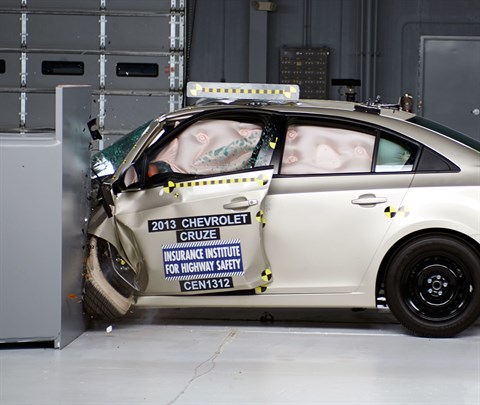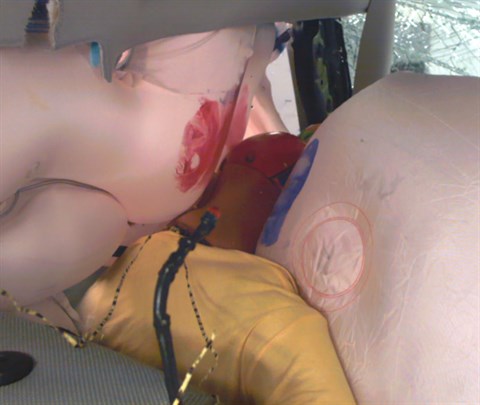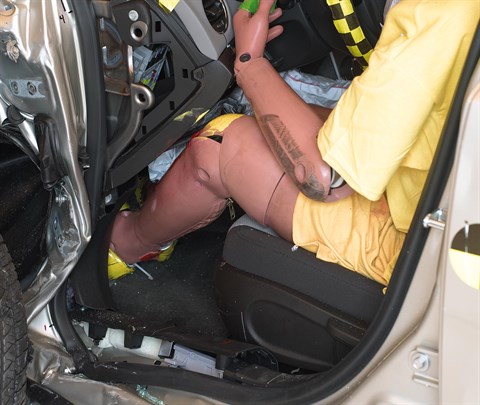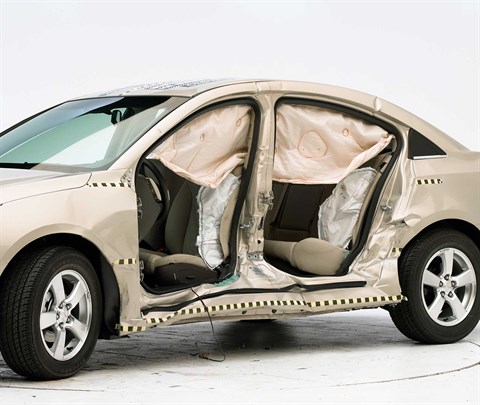Small overlap front: driver-side
Rating applies to 2011-15 models
Tested vehicle: 2013 Chevrolet Cruze LS 4-door
The Chevrolet Cruze was introduced in the 2011 model year as a replacement for the Chevrolet Cobalt. Beginning with 2013 Cruze models, the driver frontal airbag was changed to a simpler, "smart" design, characterized by General Motors as having flexible venting technology. The small overlap frontal ratings apply to both airbag designs.
Beginning with the 2016 model year, the car was renamed the Cruze Limited and sold when new only to fleets. The Cruze Limited shares no ratings with the redesigned 2016 Chevrolet Cruze.
| Evaluation criteria | Rating |
|---|---|
| Structure and safety cage | |
| Driver injury measures | |
| Head/neck | |
| Chest | |
| Hip/thigh | |
| Lower leg/foot | |
| Driver restraints and dummy kinematics The dummy’s head barely contacted the frontal airbag before sliding off the left side as the steering column moved 11 cm to the right, leaving the head vulnerable to contact with forward side structure. Additionally, the seat belt allowed excessive forward excursion of the dummy’s head and torso. The side curtain airbag deployed but does not have sufficient forward coverage to protect the head from contact with forward side structure and outside objects. The side torso airbag deployed. | |

Action shot taken during the small overlap frontal crash test.

The dummy's position in relation to the door frame, steering wheel, and instrument panel after the crash test indicates that the driver's survival space was not maintained well.

During the crash, the dummy's head barely contacted the frontal airbag before sliding off to the left as the steering column moved to the right. The seat belt allowed the dummy to move too far forward, as is evident from the gap between the seat back and the dummy's torso. The side curtain airbag did not extend far enough forward toward the A-pillar.

Despite extensive intrusion of the door hinge pillar and instrument panel, risk of injuries to the dummy's legs and feet was low.
Moderate overlap front: original test
Rating applies to 2011-15 models
Tested vehicle: 2013 Chevrolet Cruze LT1 4-door
The Chevrolet Cruze was introduced in the 2011 model year as a replacement for the Chevrolet Cobalt. Beginning with 2013 Cruze models, the driver frontal airbag was changed to a simpler, "smart" design, characterized by General Motors as having flexible venting technology.
Moderate overlap frontal ratings are assigned by the Institute based on two tests conducted by GM. The first car was a 2011 model; the second car was also a 2011 model, but the car was retrofitted with the smart airbag used in 2013 production models. As expected, the newer airbag did not contribute to any significant changes in test results. Therefore, the ratings are based on both tests, but vehicle specifications are provided for the Cruze used in the later test.
Beginning with the 2016 model year, the car was renamed the Cruze Limited and sold when new only to fleets. The Cruze Limited shares no ratings with the redesigned 2016 Chevrolet Cruze.
| Evaluation criteria | Rating |
|---|---|
| Overall evaluation | |
| Structure and safety cage | |
| Driver injury measures | |
| Head/neck | |
| Chest | |
| Leg/foot, left | |
| Leg/foot, right | |
| Driver restraints and dummy kinematics | |
Side: original test
Rating applies to 2011-15 models
Tested vehicle: 2011 Chevrolet Cruze 2LT 4-door with standard front and rear head curtain airbags and standard front and rear seat-mounted torso airbags
The Chevrolet Cruze was introduced in the 2011 model year as a replacement for the Chevrolet Cobalt.
Beginning with the 2016 model year, the car was renamed the Cruze Limited and sold when new only to fleets. The Cruze Limited shares no ratings with the redesigned 2016 Chevrolet Cruze.
| Evaluation criteria | Rating |
|---|---|
| Overall evaluation | |
| Structure and safety cage | |
| Driver injury measures | |
| Head/neck | |
| Torso | |
| Pelvis/leg | |
| Driver head protection | |
| Rear passenger injury measures | |
| Head/neck | |
| Torso | |
| Pelvis/leg | |
| Rear passenger head protection | |

View of the vehicle and barrier just after the crash test.

View of the vehicle after the crash with doors removed, showing the side airbags and damage to the occupant compartment.

Smeared greasepaint shows where the driver dummy's head was protected from being hit by hard structures by the side curtain airbag.

Smeared greasepaint shows where the rear passenger dummy’s head was protected by the side airbag.
Roof strength
Rating applies to 2011-15 models
Tested vehicle: 2011 Chevrolet Cruze LS 4-door
Rating applies to both the Chevrolet Cruze (tested) and the structurally similar Buick Verano.
| Overall evaluation | |
|---|---|
| Curb weight | 3,143 lbs |
| Peak force | 15,944 lbs |
| Strength-to-weight ratio | 5.07 |
Head restraints & seats
Seat type: Manual cloth seats
| Overall evaluation | |
|---|---|
| Dynamic rating | |
| Seat/head restraint geometry |
About the head restraint & seat test
Currently, IIHS tests apply only to front seats.
